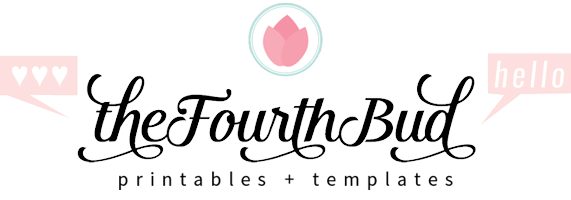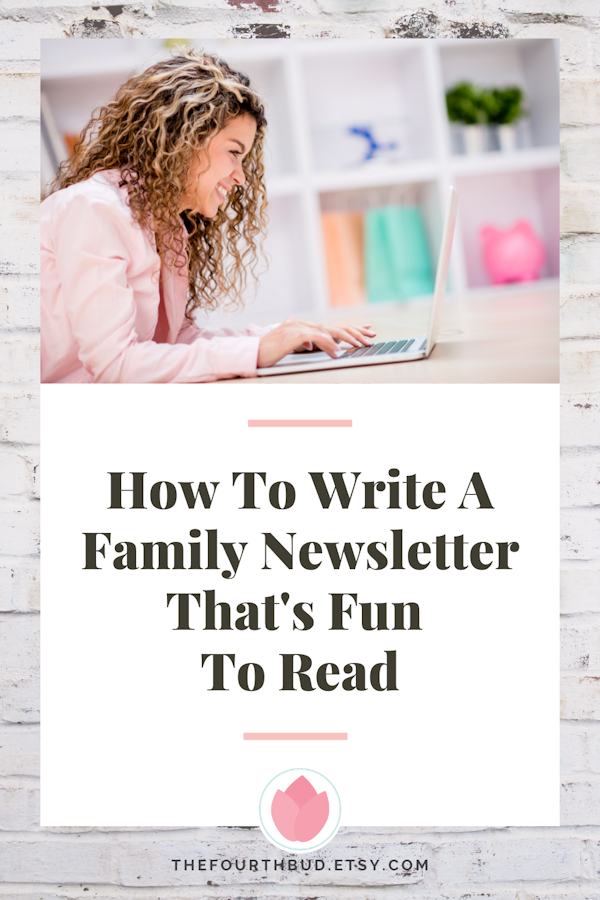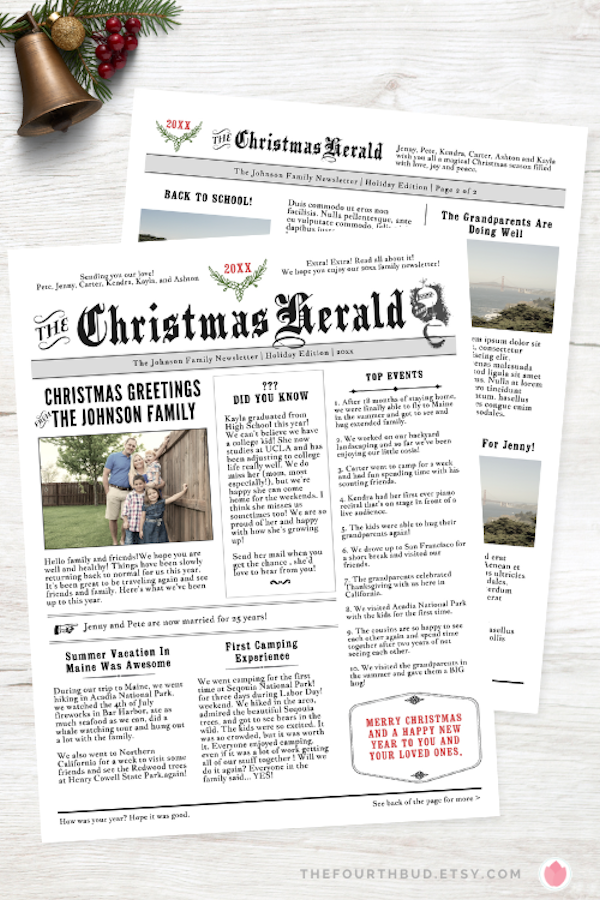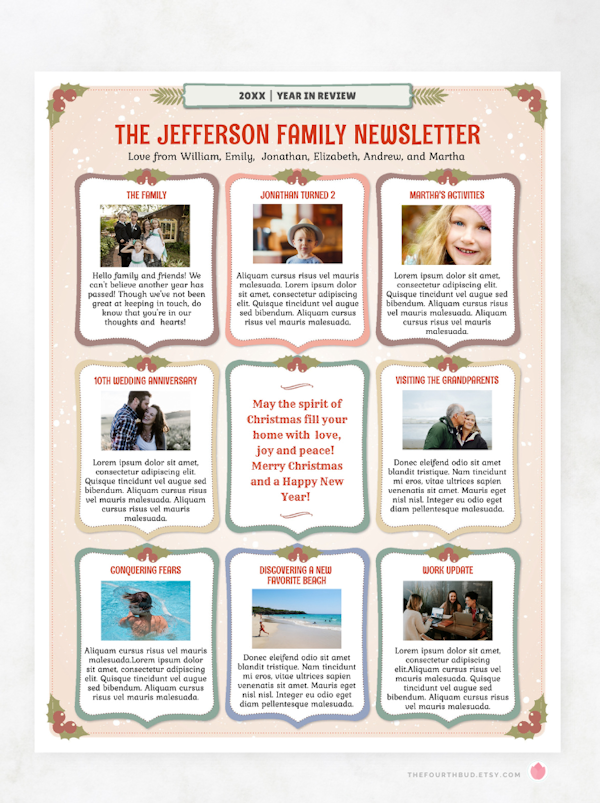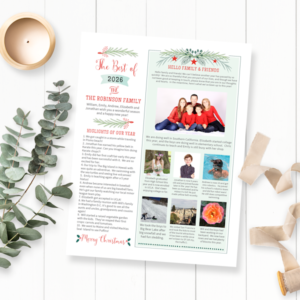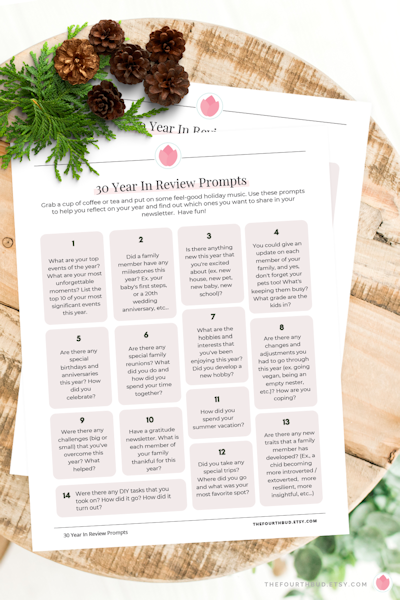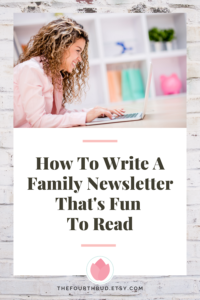A family newsletter is a great way to update family and friends on what we’ve been up to in the past year.
If you haven’t sent out a family Christmas newsletter before and you’re interested in starting one, but don’t know where to begin, here are some ideas that can jumpstart you to easily write a family newsletter that will delight your recipients.
When you’re done, you’ll have a newsletter you’ll be proud of that you can’t wait to share. The kind of newsletter that your family and friends will enjoy reading. They’ll even look forward to it in the next year. It’ll be so good you may want to keep one for yourself as a record of your year! And, it’ll be so special that your recipients may even want to keep it too!
Let’s get started…
Know who you’ll be sending your family newsletter to
Think about who your readers are. Let this be your guide to the tone of your writing and the kind of content you’ll be sharing.
Even if the newsletter is going to be sent only to your family and friends, there are still some things you’ll be more comfortable sharing to some of them and not to others. I know the grandparents in my family would love to hear about all of my children’s achievements and awards, but I’m not so sure my cousin would.
TIP: If thinking of the group of people you’re sending your newsletter to makes you start sweating, how about starting with Dear mom / dad / sister / best friend / whoever you’re comfortable speaking to. It’ll make writing less overwhelming. Also, according to Anne Handley in her book Everybody Writes, this “helps relax your writing voice into sounding natural and loose and accessible”.

Acknowledge your readers
It’s a letter after all. It’s just natural to address and acknowledge your readers. Check on them. Ask how they’re doing. It could be as simple as …
“Hello family and friends! Hope you’re doing well and in good health! So many things happened and so we thought we’d share them in our very first family Christmas newsletter! Here’s a recap of our year! Enjoy! “
TIP: You can do this part last. When you’re done with your letter, go back and write your opening using a brief summary of what you’ve just shared on your newsletter. For example…”…This year was filled with emotional reunions, challenges we overcame, and new experiences for our family. We are thankful for it all…”
Let’s talk about what you’re going to write
Here are some ideas on what you can share in your family newsletter just to get you started.

You can share the highlights of your year. Start with a list of the top events and milestones of your family’s year.
You can share updates about the members of your family. And yes, you can include pets here too!
Write about the events and experiences that were a big deal to you and your family. There’s no need for an exhaustive list of everything you did in the year. That said, if your family thinks losing Lucy’s first tooth is a big deal that’s worth sharing, then include that! If giving up your TV was a challenge that made a big impact on your family life, then you can mention that too. A newsletter doesn’t have to be filled with only achievements and extravagant vacations. You’d be surprised at how a simple thing that’s a big deal to you is more fun to read than a detailed list of fancy restaurants you went to in Paris. (But then again, if your readers are folks who share your love of restaurants in Paris, then go right ahead! 🙂 )
You can also share more details about the events that you know your readers will want to know more about. Now let’s get back to that example of giving up the TV, I’m dying to hear more on what that experience was like! 😉
Share what you feel about the event or memory, not just the event itself. Your recipients will want to know more about what you think of the event than the event itself. For example, instead of saying “Jenna had her very first piano recital in July”, you could say, “Jenna was so nervous on her first piano recital, but she did so well, we’re so proud of her.”
It’s ok to also share some failures and some not-so-good events that made an impact on your family, and you can even add how you’ve overcome it. (But only if you’re comfortable in sharing them.)
For example:
“Carter ran for vice president of his school’s student council. He was disappointed that he lost, but we’re all so proud of his speech and the fact that he ran. His enthusiasm was unexpected. Future politician in the works maybe? 🙂 “
Use photos. Use family photos as your prompts for talking about an event or a family member. Or, you can also just use photos and add a brief caption, because sometimes, things are just better explained with a photo than by describing them in words!

Include your contact information, if you’d like your readers to keep in touch with you. What’s the best way to reach you? Other than your home address or your mobile number, you can also share your email address and social media accounts if you prefer to keep in touch that way.
—–
Do keep in mind that these ideas are only suggestions to help you brainstorm on what to include in your newsletter. The purpose of a family newsletter is to keep in touch and give an update to family and friends. Just because you didn’t have an eventful year doesn’t mean you can’t send a family Christmas newsletter.
Let’s talk about your writing style

Keep it brief and concise, if you can. Try not to share every detail. You don’t want to end up with 5 pages of your year. That’s a lot of reading for your folks! We don’t want them to put it aside to read for later only to be forgotten. In the article, How to Write Well, Even If You Don’t Write for a Living, Jory MacKay advices to “use short, simple words”. He adds, “…most people advise that you stick to a 5th grader’s level of knowledge. That means short, snappy words, minimal adjectives and adverbs, and no jargon.” Writing at a 5th grader’s level may be extreme for you, but you get the gist.
Be conversational and be YOU. Write the way you speak to a friend. I swear your recipients will hear your voice in their heads as they read your newsletter.
Keep the tone light and cheerful, if you can. You can even inject some of your own humor. Even a side remark like a LOL on something you think is funny helps.
Stay positive. If this year had been particularly difficult for you and your family, you don’t have to mention all the gritty details of why it was so difficult.
If you’re sharing not-so-good news, like an illness, loss of work, or loss of a loved one, try your best to be hopeful even if it’s hard. We would rather not leave our readers heavy hearted with a cloud over their heads. Let’s have them cheering for us instead!
Don’t worry too much about grammar, punctuation and format. Remember that this is an informal piece of writing. It’s not a school paper or an official publication.
Write to express, not impress. This is an advice by Jory MacKay also mentioned in his article, How to Write Well, Even If You Don’t Write for a Living. I really like this, especially when it’s applied to writing a family newsletter. Keeping this in mind will help prevent your newsletter from sounding like an annoying brag letter.
Think about the format of the newsletter
A family newsletter doesn’t have to be written like an essay. You can be as informal as you want. Write it however you feel like. Get creative. You can do a numbered list of top events, or write it in the perspective of your pet (I’ve read some people actually do this!). You can print on a holiday stationery or you can send it digitally. You can also use one of my fun Christmas newsletter templates that will make it easy to get you started.
In the Christmas newsletter templates below, your readers can choose which parts to read first making your newsletter easier and more enjoyable to read.
Have a closing message
Have an ending to your newsletter. Wishing your recipients well with a simple “We wish you and your loved ones a wonderful Christmas and a happy and healthy new year!” is much better than not having an ending at all. It’s like a conclusion to your newsletter… but not really saying IN CONCLUSION…because that…is just silly! 😉
Have your family members read your newsletter before distributing it

“If you’re concerned about your tone or that you’ve included overly sensitive details, let a trusted loved one give your newsletter a once-over before you send it out to the masses”, said Anna Goldfarb in her New York Times article, How to Write a Family Newsletter Your Friends Will Actually Read.
See if everyone’s comfortable with the information you shared and how you wrote it.
A different perspective can also help you find out if the newsletter sounds like you’re updating family and friends or if it sounds like you’re trying to impress them! You’ll receive more happy feedback on your newsletter by going for the former.
And that’s it!
As you begin to write your newsletter, you now know to first think about who your readers are. You also now have ideas on on what you could write about and how to write it. Then, decide on the format of your newsletter and how you’re going to send it. And remember that at the end of the day, it’s YOUR family newsletter. YOU should have fun writing it, too.
Keep these ideas and suggestions in mind. Take only the ones that resonate with you. Every family is different. I wouldn’t be surprised if you hear back from your family and friends on how much they’ve enjoyed reading your newsletter this year!
The Fourth Bud Etsy Shop creates fun and beautiful templates that can help make Christmas newsletter writing quick and easy! Over 8,000 templates have been sold and enjoyed by many families. The layout and design of these tempates are all done for you. All you need to do is to have fun entering your information. Learn more about the templates in the shop.
30 YEAR IN REVIEW PROMPTS
If you need more ideas on what to write in your newsletter this year, download the FREE 30 Year in Review Prompts. It’ll help you reflect on the things that happened this year that you may have already forgotten about. See which memories and events you’d like to share to family and friends.
